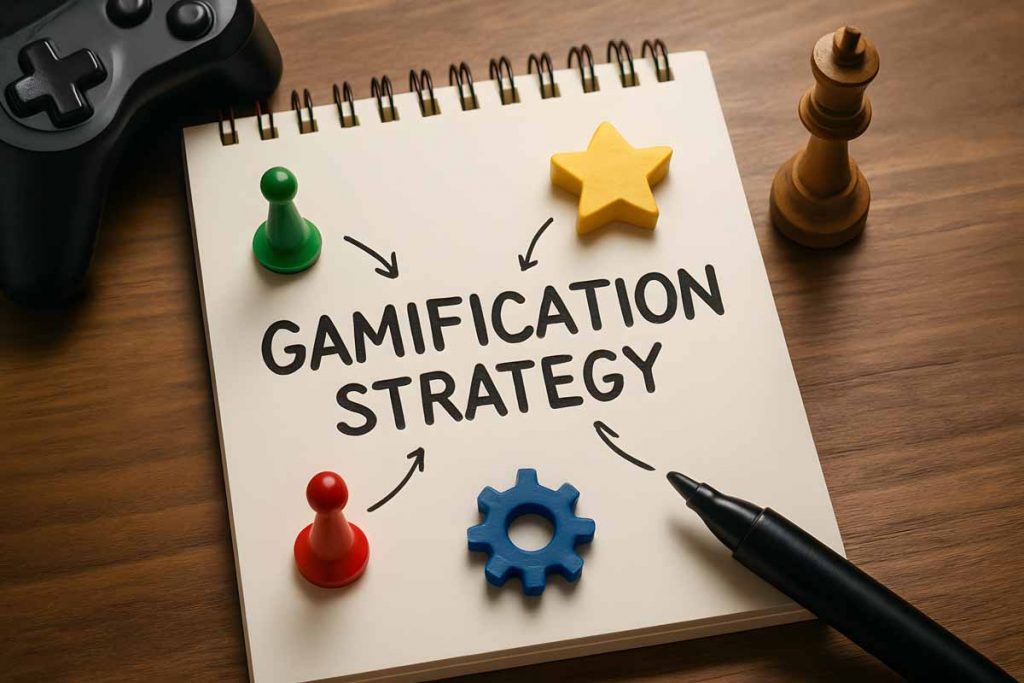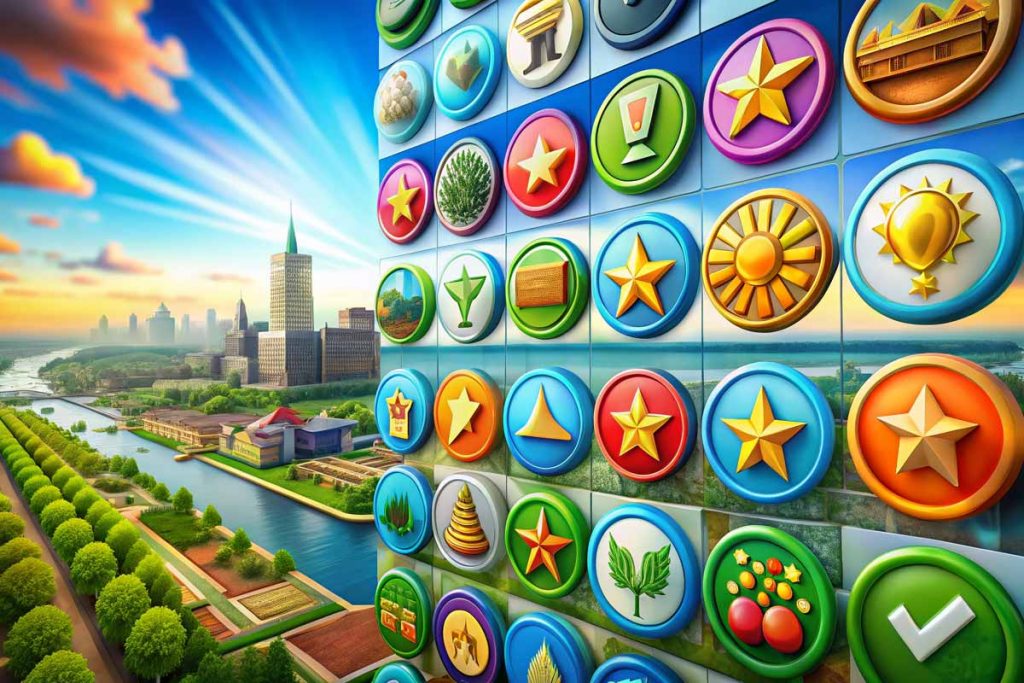Gamification motivates people in a wide range of areas
Gamification works in many areas, from employee health to climate protection and learning. It lowers entry barriers by presenting tasks in a playful way, sparking interest and encouraging participation. In health or climate protection, gamification not only aims to motivate but also to foster lasting behavioral change, such as increasing physical activity, promoting healthier eating, or encouraging more responsible use of resources.
7 examples of successful gamification
The following examples demonstrate how versatile gamification can be for boosting motivation. Sometimes it’s about climbing a leaderboard, other times about earning virtual goods or real-world rewards. In every case, it’s about the fun of playing while achieving a wide variety of goals.
The Klima-Taler App promotes climate-conscious behavior through gamification
The Klima-Taler App is a good example of various gamification elements. The sustainability app uses a game currency generated through CO2 savings. Users can see how each Klima-Taler gradually fills up through their own efforts and is then collected as a complete Klima-Taler in their wallet. This creates an attractive incentive, as Klima-Taler can be redeemed online or with local climate partners. In addition, there are virtual goods in the form of badges.
A major motivation to keep participating comes from community competitions. Cities can launch their own challenges to save as much CO2 as possible through walking, cycling, or using public transport. Cities, clubs, and schools can also compete with each other in leaderboards.
Another motivating factor is the visible contribution to climate protection. The app not only displays individual achievements but also allows participating municipalities to showcase climate-friendly kilometers traveled per mode of transport, CO2 saved, and Klima-Taler earned and redeemed. This is a form of gamification for municipal climate protection, enabling participants to experience self-efficacy while municipalities can use anonymized mobility data for forward-looking traffic planning. The Klima-Taler App can be downloaded for free on smartphones.
Gamified reward system for mobility participants
The “Gamified Speed Camera Lottery” in Stockholm is a creative gamification example in traffic safety. Drivers who obey the speed limit are automatically entered into a lottery funded by fines collected from speeders. This playful reward system motivates drivers positively, rather than relying solely on penalties.
The public traffic safety campaign achieved a significant effect—the average speed dropped by 22%. It is a simple idea with great success, demonstrating that the prospect of a reward can change behavior more sustainably than the fear of punishment. Unfortunately, this was still a limited-time trial and, despite its success, has not yet been implemented on a long-term basis.
Health prevention made fun with the Changers Fit App
The “Changers Fit App” makes it easier for companies to motivate employees to take better care of their health. The app combines health prevention with climate protection and uses gamification to encourage long-term behavior change. Employees can earn coins through activities such as running, cycling, healthy eating, participating in health checks, or using fitness programs. These coins can be used as virtual currency for raffles, rewards, or vouchers.
Team challenges, leaderboards, and digital badges foster competition and strengthen the sense of community. Additionally, the app links individual behavior with social and ecological impact, for example through tree-planting campaigns or donation projects. Companies use the app to motivate employees to develop healthy routines over the long term while simultaneously supporting their CSR goals. The “Changers Fit App” has received multiple awards, including the EUPD Top Brand “Corporate Health.”
Solving scientific problems playfully with Foldit
An example of gamification used to advance scientific progress is Foldit. This online game was launched in 2010 by the University of Washington to predict protein structures, which is important for various fields in medicine, bioinformatics, and molecular biology.
Players, who are non-experts, work with real research data and try to fold proteins into the most stable shapes possible. Points, leaderboards, and visual feedback provide motivation and encourage players to develop increasingly better solutions. The solutions are then evaluated by research teams for their real-world viability. The community has successfully discovered previously unknown structures that have been used in scientific research.
Millions of people collect trash on World Cleanup Day

World Cleanup Day takes place every year on the third Saturday of September. On this day, millions of people worldwide come together to collect trash and actively contribute to environmental protection. Gamification is key to engaging so many people in environmental action on this day.
Through community challenges and group leaderboards, a strong sense of togetherness is created, motivating people to participate. Social media competitions further increase visibility and add fun, attracting even more volunteers. The playful elements make trash collection not only meaningful but also a social experience. Supported by NGOs and movements such as “Let’s Do It! World,” the initiative thrives on a shared mission and mutual motivation.
Pain squad helps children with cancer manage pain better
This good gamification example focuses on increasing motivation in a very challenging situation. Pain Squad is an app from Canada that helps children with cancer regularly document their pain using gamification. Young patients are incorporated into a virtual detective team. In their role as investigators, they report their pain symptoms.
The normally unpleasant task of recording data is transformed into a motivating mission through child-friendly game design. Developed by the Hospital for Sick Children in Toronto, the project uses points, roles, and storytelling to significantly increase participation rates. The collected data is valuable for doctors to tailor treatments more precisely and improve the children’s quality of life. The app continues to be used successfully today and serves as a proven example of how gamification can increase compliance in healthcare.
Learning to read and write outside school with Antura and the Letters
The game “Antura” is an open-source project developed to help children in crisis areas learn to read and write in a playful way. Through an adventure game, literacy becomes more accessible and motivating for children in war and crisis zones. Engaging stories and interactive tasks keep children involved for longer and encourage regular practice.
“Antura and the Letters” can be downloaded for free on smartphones or PCs in multiple languages, including Arabic, English, German, Polish, Spanish, and Russian, and it also works offline. Organizations such as NGOs, educational foundations, and UNESCO use this digital learning tool in refugee camps, where traditional educational opportunities are often lacking. The positive learning outcomes demonstrate that gamification can help improve educational opportunities.
Key aspects for guccessful gamification

For gamification to be truly successful, the playful elements should be well tailored to the target audience and context. The difficulty level should be set so that tasks are challenging but achievable. Quick feedback, such as points or incentives, is important. The game system must be easy to understand to keep participation low-threshold and avoid frustration.
When gamification elements are integrated meaningfully, they do not distract from the main goal. Team competitions or leaderboards strengthen the sense of community and encourage long-term engagement. Linking virtual feedback with real-world impact, such as in climate protection, also increases identification with the topic. Above all, gamification should be fun and foster a sense of self-efficacy, so that users actively and voluntarily participate.
Advantages and applications at a glance
Gamification uses playful elements such as points, rewards, and competitions to motivate people in a wide range of areas, from education and health to climate protection. Examples of gamification, such as the “Klima-Taler App” or the “Changers Fit App“, show how playful incentives can promote sustainable behavior change. Innovative projects like the scientific game Foldit or the Pain Squad App in healthcare also use gamification to make complex tasks more accessible and increase engagement. Successful gamification combines fun with a clear goal, creating motivation and opportunities to try out new behaviors.
If you have questions about how to promote municipal climate protection through gamification, please feel free to contact us and learn how easy it is to become part of the Klima-Taler network.

Markus Schulz
markus@klima-taler.com

